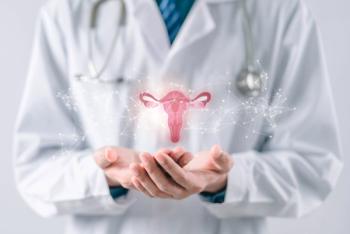
Laparoscopic Supracervical Hysterectomy
OBGYN.net Conference CoverageFrom American Association of Gynecological LaparoscopistsAtlanta, Georgia, November, 1998
Roberta Speyer: “This is Roberta Speyer, Publisher of OBGYN.net, and I’m reporting from Atlanta, Georgia at the American Association of Gynecological Laparoscopists annual meeting. I’m speaking to Dr. Glen Bradley, Gynecologic Surgeon from Santa Maria Medical Clinic of Obstetrics and Gynecology in Santa Maria, California. Dr. Bradley presented a really interesting video presentation of laparoscopic supracervical hysterectomy that I had the privilege to sit in on. Dr. Bradley, I found it fascinating and I was wondering if you could share a little bit about this procedure with the OBGYN.net readers because I think they’ll find it very interesting.”
Dr. Glenn Bradley: “This procedure basically entails the removal of a diseased uterus - the body of the uterus - with or without the ovaries if it’s so indicated but leaving this very important structure, the cervix, in the pelvis. In the past, people have assumed that the cervix played no real role in women’s pelvic support, for example, but as we learn more about this we realize the cervix is the central tethering point, if you will, for the pelvic diaphragm. Not only does it do that but it has a very abundant nerve supply and so it does transmit not only pain sensation from this region but also pleasurable sensation. For example, sexually, women have one or both types of orgasm, one being external which is clitoral and then the internal orgasm which is referred to as the “G spot.” In actual fact, this pleasurable sensation comes from a nerve supply that’s very abundant around the cervix. So by maintaining the cervix, we can enhance the long-term support of the pelvic diaphragm to minimize potential prolapse at a later date, and we also maintain this very vital nerve supply intact for an enhancement of sexual function after the surgery. But there are many other reasons why laparoscopic supracervical hysterectomy, in my opinion, will become almost the standard for removal of the diseased uterus - meaning the body of the uterus. By not violating the integrity of the cervix, its attachments to the uterus, its relationship to the bladder, it will actually make this laparoscopic procedure available to almost all women with the exception of those say with cancer and/or significant prolapse because the technology is now here. We can do this operation in almost the same operating time as we would open but the advantage is the amount of post-operative pain and the rapidity of recovery is absolutely astonishing.”
Roberta Speyer: “If I were going in to have a hysterectomy, I had looked at other alternatives, and it was decided that indeed having a hysterectomy was the route that an individual, myself, should take - what would be the indications to do it this way, and what would the other ways have been like? A woman like myself, when you say hysterectomy, they all sound the same to me. What’s the difference? How do I know…?”
Dr. Glenn Bradley: “By definition hysterectomy means removal of the uterus. The uterus has two essential parts to it, if you will, the entrance to the uterus, which is called the cervix, and that’s where it’s attached to the vagina, and the upper portion or the body of the uterus. It is problems most often associated with the body that’s responsible for a hysterectomy. Conventionally in the past, we would either remove this diseased organ with the cervix because it was believed it played no role, either through the vagina, in which case we had what’s called a vaginal hysterectomy or removal of the uterus, meaning the body and the cervix through a rather large abdominal incision. The latter procedure’s called a total abdominal hysterectomy. It’s associated with about a four to five day hospital stay then maybe a six-week recuperation time. Vaginal hysterectomy because it avoids an abdominal incision can result in a rather shorter hospital stay, perhaps three days, maybe two and faster recuperation, and the patient pretty well getting back to normal maybe in four weeks. Nonetheless, with either operation there is an incision in the vagina so intercourse is precluded for six weeks. On the other hand, if we do the laparoscopic supracervical hysterectomy, we are able to remove this tissue from the body of the uterus irrespective of the size of the uterus, whether the body of the uterus is the size of a two-month pregnancy or a four-month pregnancy such as with fibroids. We now have the instrumentation available to remove this tissue through a tiny incision that’s about 14 mm in diameter so the size and quantity of tissue to be removed is no longer a factor in performing it laparoscopically. It is essentially so much simpler for the surgeon. No suturing is required using the technique that I have adopted, and it is virtually bloodless but the most astonishing part is the fact that it is almost painless, in fact, I call it the ‘pain-less’ hysterectomy. Many of these patients will use no pain medication post-operatively. As an example, one case we performed just prior to my coming to the meeting required a total operating time of forty-eight minutes, skin to skin, and I finished the case in about forty-eight minutes. This patient called me six hours later right after lunch and said, “Can I go home?” And I discharged her home. The patients are resuming intercourse at eight to ten days after surgery. In fact, the numbers are rather amazing because I just reviewed the series that we have. It would appear that 60% of the patients who have laparoscopic supracervical hysterectomy have resumed 95% of their normal activities in three days, and 86% have resumed 95% of their normal activities in five to seven days. What does that mean? It’s easier to say - what do I tell them not to do? I say don’t go to the gym for a couple of weeks but otherwise you drive your car when you’re ready. You can go out to dinner when you’re ready, you go to the school and pick your kids up when you feel like it, and the number of pain pills they use is minimal to none. So here we have an operation that can be performed by most gynecological surgeons. It does not require an enormous amount of skill because the procedure is straightforward. It has very low complications, it uses minimally invasive surgical technique and the patients recovery is almost immediate.”
Roberta Speyer: “How many of these have you done, Dr. Bradley?”
Dr. Glenn Bradley: “Since December, we’ve attempted sixty-seven and have been successful in sixty-four. Three for a variety of technical reasons, I had to convert to a conventional. But of course, we have to say that to everyone - we don’t know if we can do it this way until it’s over. It would appear that the vast majority of hysterectomies which are performed largely for bleeding, cramps, pain, and fibroid tumor as examples can be accomplished this way.”
Roberta Speyer: “That’s fascinating. I really enjoyed the video, and I hope to have that video online for our viewers to see because I think no matter what we discuss, seeing is truly believing, and what a difference that is.”
Dr. Glenn Bradley: “One picture is worth a thousand words.”
Roberta Speyer: “What does a woman do, unfortunately, we can’t all live in Santa Maria and have you do this if we need a hysterectomy - how widespread is this being accepted as a procedure? What should a woman look for when she goes to her own gynecologist, and what questions should she ask?”
Dr. Glenn Bradley: “I think the interest in this particular technique is really quite enormous because it really is the first major move forward in hysterectomy technique in many, many years, and here at this meeting many of the surgeons are already performing it. At one of the meetings I was at yesterday, I was surprised to find in the audience there were several dozens in this group of maybe one hundred or two hundred gynecologists that are already doing it. So I think one thing you could do as with any type of referral that a patient may require in her own community, she can contact the medical society and the major hospitals in her community. She can ask the head nurse in the operating room – are they doing this particular procedure.”
Roberta Speyer: “We will certainly be glad to do that. Tell us again what the name of it and what women should be mentioning and getting the word out there on?”
Dr. Glenn Bradley: “The procedure is called a “laparoscopic supracervical hysterectomy.”
Roberta Speyer: “And it’s something, I think, every woman should find out more about.”
Dr. Glenn Bradley: “In my opinion, unless an individual has either cancer or significant prolapse, basically, I do every case this way because it’s such an improvement.”
Roberta Speyer: “Are there cases with fibroids? We on OBGYN.net have had a few pictures sent in of fibroids, and one was the size of a watermelon. Is there a point with the fibroid where this just can not be done this way?”
Dr. Glenn Bradley: “I think the answer to this question really requires surgical judgment on the part of the surgeon, and sometimes for technical reasons it’s not safe to proceed in a given way. Therefore, it requires surgical judgment to say – let’s do it the conventional way.”
Roberta Speyer: “But that is probably a minority?”
Dr. Glenn Bradley: “That’s true but in terms of the very large ones, there are medications that we can give patients for two to three months prior to surgery that will shrink the fibroid by up to 50%.”
Roberta Speyer: “What type of medications would those be?”
Dr. Glenn Bradley: “Fortunately, using a drug called a GnRH agonist will result in about a 50% reduction in the volume of the fibroid over a two to three month period. So that initially, a fibroid that was large enough to perhaps be of concern and perhaps not appropriate for this operation, in the majority of patients can be shrunk down after that interval so that it can be done.”
Roberta Speyer: “Just another point of curiosity, once that fibroid has been shrunk, if they go off the medication, will it grow back usually?”
Dr. Glenn Bradley: “The medications provide a window for definitive treatment and unless that patient has a myomectomy, for example, if it’s a large fibroid and/or definitive surgery that we’re talking about, 85% of the cases are back to their original size within six months.”
Roberta Speyer: “Could you share with us a little bit, and I know every case is different, about when the treatment for fibroids leans more towards when you would recommend a laparoscopic supracervical hysterectomy or when you would look for an alternative?”
Dr. Glenn Bradley: “There are many pieces of equipment that have been developed now to provide control of bleeding for large fibroids, this is called endometrial resection and ablation, and there’s a variety of companies who have their own particular devices. In my opinion, if the fibroid is really small and the aggregate size of the uterus is not more than say a 2 ½-month pregnancy, one might consider doing what’s called a resection and an ablation, and this will be successful in the majority of patients. On the other hand, if it’s say a three-month size or larger, for the majority of patients it will not prove to be long term. Another factor to consider is the patient’s age because if the patient is less than forty-five years old, the likelihood of her subsequently requiring hysterectomy several years later because the fibroids grew again is a factor that one has to think about and it may be as high as 35%. The patient who is forty-five and older, the hysterectomy alternative of endometrial resection and ablation is really quite good because it’s usually very successful long term. If there are associated problems such as pain, if the patient says I only bleed very heavily, I have to change every hour, but I have horrible cramps and/or my uterus is really tender or intercourse is miserable because I have such pelvic pain and tenderness, in that situation, in my opinion, this operation can be performed so readily and solve all these other problems, that in my view, it needs to be looked at very, very carefully.”
Roberta Speyer: “I think this is really going to help the OBGYN.netters, and I really appreciate you taking the time to talk with us about this. Thank you very much, Dr. Bradley.”
Dr. Glenn Bradley: “Thank you very much.”
Newsletter
Get the latest clinical updates, case studies, and expert commentary in obstetric and gynecologic care. Sign up now to stay informed.










